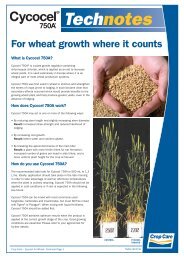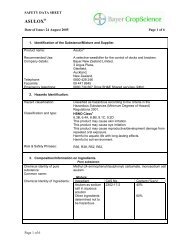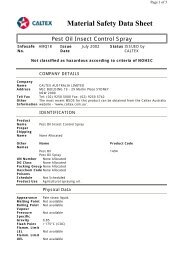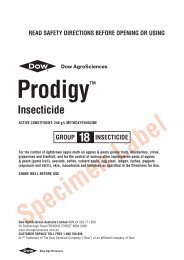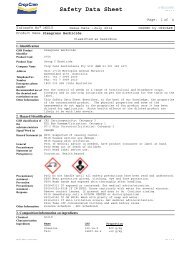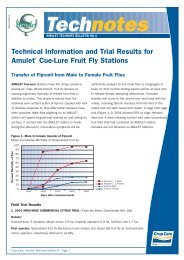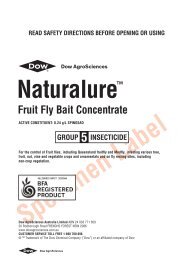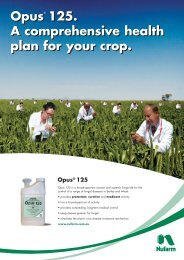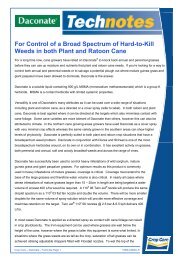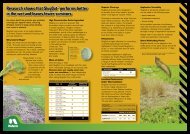Template NUF EPG IERG 36 - Pest Genie
Template NUF EPG IERG 36 - Pest Genie
Template NUF EPG IERG 36 - Pest Genie
Create successful ePaper yourself
Turn your PDF publications into a flip-book with our unique Google optimized e-Paper software.
EMERGENCY PROCEDURE GUIDE – TRANSPORT<br />
CORROSIVE LIQUID, BASIC, ORGANIC, N.O.S<br />
Emergency Response Guide <strong>36</strong> [ HB 76 – 2004 ]<br />
Proper Shipping Name:<br />
CORROSIVE LIQUID, BASIC, ORGANIC, N.O.S<br />
(METHAM SODIUM)<br />
TRADE NAME UN No HAZCHEM<br />
METHAM SOIL FUMIGANT 3267 2X<br />
EMERGENCY CONTACTS<br />
POLICE OR FIRE BRIGADE DIAL: 000 – if ineffective Dial 1100 (exchange)<br />
Organisation Location Telephone Ask for<br />
Nufarm Limited Laverton North 1800 033 498<br />
Shift<br />
Supervisor<br />
HAZARDS<br />
Fire or explosion<br />
Health<br />
Protective Clothing<br />
Public Safety<br />
May burn but does not ignite readily.<br />
Containers may explode when heated.<br />
When heated, vapours may form explosive mixtures with air.<br />
Contact with metals may evolve flammable hydrogen gas.<br />
Runoff may pollute waterways.<br />
May be transported in a molten form.<br />
Fire may produce irritating, poisonous and/or corrosive<br />
gases.<br />
Some may decompose explosively (D) or polymerise<br />
violently (P) when heated or involved in a fire.<br />
POISONOUS, MAY BE FATAL IF INHALED,<br />
SWALLOWED OR ABSORBED THROUGH SKIN.<br />
Inhalation, ingestion or contact with substance may cause<br />
severe injury or death.<br />
Contact with molten substance may cause severe burns.<br />
Runoff from fire control or dilution water may be poisonous<br />
and/or corrosive and pollute waterways.<br />
Wear SCBA and chemical splash suit.<br />
Fully-encapsulating, gas-tight suits should be worn for<br />
maximum protection.<br />
Structural firefighter’s uniform is NOT effective for these<br />
materials.<br />
IMMEDIATELY CONTACT POLICE OR FIRE BRIGADE.<br />
Spill or leak area should be isolated immediately for at least<br />
25 m in all directions.<br />
Keep unauthorised personnel away.<br />
Keep upwind and to higher ground.<br />
Ventilate enclosed spaces before entering.
Evacuation<br />
Fire<br />
Spill or Leak<br />
Large Spill<br />
Consider initial downwind evacuation for at least 250m.<br />
Fire<br />
When any large container (including rail and road tankers)<br />
is involved in a fire, consider initial evacuation for 800 m in<br />
all directions.<br />
EMERGENCY RESPONSE<br />
Small fire<br />
Use dry chemical, CO2 or water spray.<br />
If safe to do so, move undamaged containers from fire area.<br />
Large fire<br />
Use dry chemical, CO2, foam or water spray – Do not use water jets.<br />
Cool containers with flooding quantities of water until well after fire is out.<br />
Avoid getting water inside containers.<br />
Fire involving tanks<br />
Fight fire from protected position or use unmanned hose holders or monitor<br />
nozzles.<br />
Withdraw immediately in case of rising sound from venting safety devices or<br />
discolouration of tank.<br />
ALWAYS stay away from tank ends.<br />
ELIMINATE all ignition sources (no smoking, flares, sparks or flames) within<br />
at least 15m.<br />
Do not touch or walk through spilled material.<br />
Do not touch damaged containers or spilled material unless wearing<br />
appropriate protective clothing.<br />
Stop leak if safe to do so – Prevent entry into waterways, drains or confined<br />
areas.<br />
Cover with plastic sheet to prevent spreading.<br />
Absorb with earth, sand or other non-combustible material and transfer to<br />
container.<br />
DO NOT GET WATER INSIDE CONTAINERS.<br />
SEEK EXPERT ADVICE ON HANDLING AND DISPOSAL.<br />
FIRST AID<br />
Remove victim to fresh air – Apply resuscitation if victim is not breathing –<br />
Do not use direct mouth-to-mouth method if victim ingested or inhaled the<br />
substance; use alternative respiratory method or proper respiratory device -<br />
Administer oxygen if breathing is difficult.<br />
Remove contaminated clothing and shoes immediately.<br />
In case of contact with material, immediately flush eyes or skin with running<br />
water for at least 15 minutes.<br />
For minor skin contact, avoid spreading material on unaffected skin.<br />
Keep victim warm and quiet – Obtain immediate medical care – Ensure that<br />
attending medical personnel are aware of the identity and nature of the<br />
product(s) involved, and take precautions to protect themselves.<br />
CONTACT POISONS INFORMATION CENTRE (13 11 26) FOR FURTHER<br />
ADVICE.<br />
** The emergency procedures specified on this card should be followed unless more product-specific information,<br />
indicating a lesser degree of risk, is available at the scene of the emergency.



